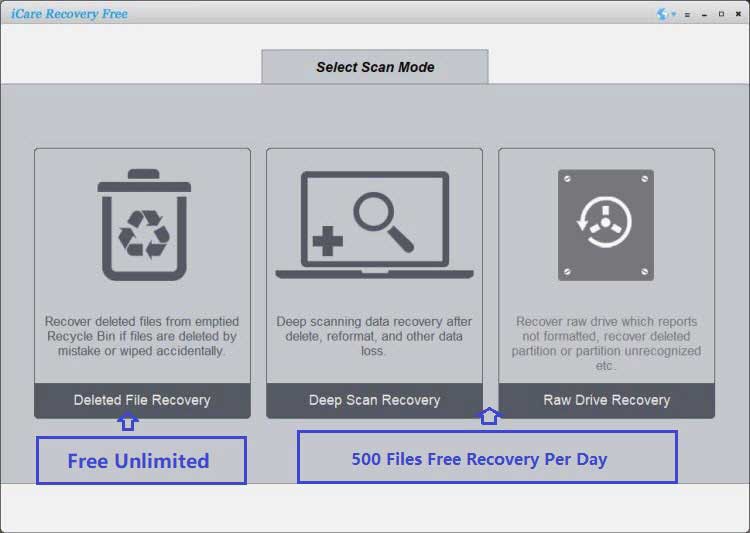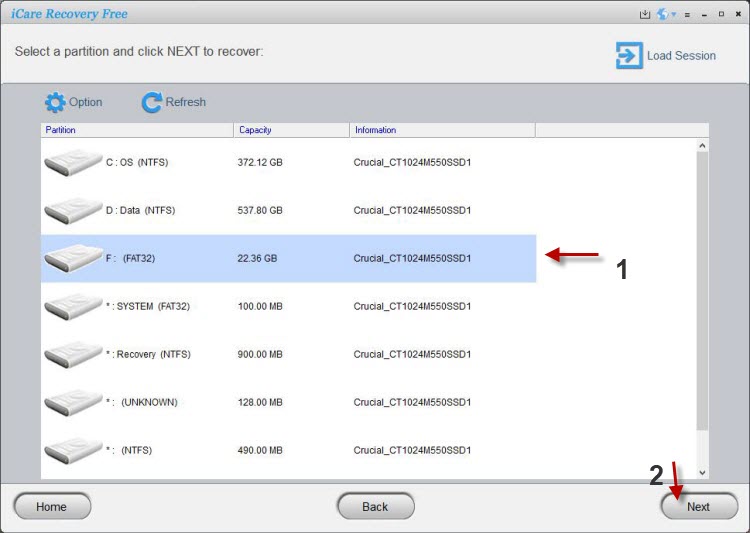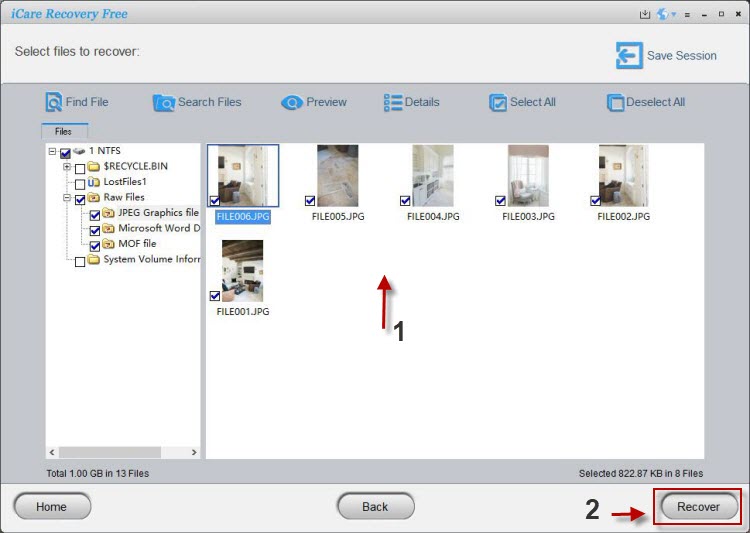SD Card Recovery App for Android or Windows
An SD card recovery app is a powerful tool designed to help users retrieve deleted, lost, or corrupted files from their memory cards. Whether you accidentally formatted your SD card or lost data due to corruption, file deletion, improper operations or other fault, these apps can often bring your files back with just a few clicks. Note: The sd card recovery tools no matter on Android phone or a computer can only recover logically damaged lost files, it cannot recover data from a physical damaged SD card.
Popular SD Card Recovery Apps on Windows
Here are some of the most popular and reliable apps available:
- iCare Recovery Free: A completely free tool with a simple interface for recovering deleted or lost files from SD cards, USB drives, and external hard disks. Offers advanced free sd card recovery with Deep Scan Recovery mode.
- Recuva: A free and easy-to-use option for basic recovery needs.
- Disk Drill: Offers deep scanning and recovery on both Windows and macOS. (500MB free recovery, commercial)
- PhotoRec: A powerful open-source tool that supports numerous file types.
- EaseUS Data Recovery: Known for its intuitive interface and high recovery rate. (500MB free recovery, commercial)
- Stellar Data Recovery: Ideal for both beginners and professionals. (Commercial tool)
Why and How to Use iCare Recovery Free
Why Choose iCare Recovery Free? It offers deep, in-depth file recovery algorithms for free and can find more files compared to other free tools. Easy to use, powerful in scanning, and effective at recovering lost data from SD cards.
Follow these steps to recover lost files using iCare Recovery Free:
- Step 1:
 Download and install iCare Recovery Free from the official website.
Download and install iCare Recovery Free from the official website. - Step 2: Launch the program and choose a recovery mode (Deleted File Recovery, Deep Scan Recovery, or RAW Recovery).

- Step 3: Select the SD card from the list of available drives.

- Step 4: Let the software scan the card. This may take a few minutes depending on the card size.
- Step 5: Preview recoverable files and select the ones you want to restore.

- Step 6: Save recovered files to a different drive to avoid overwriting.
Android SD Card Recovery App
If you've lost photos, videos, or documents on your mobile device, an android sd card recovery app can help retrieve them directly from your phone or by using a PC. These apps are designed to scan your Android phone’s external storage and restore data with minimal technical steps.
Best SD Card Recovery Apps for Android Phone
Below are some of the top-rated sd card recovery app for android phone options:
- DiskDigger Photo Recovery: Recovers deleted photos from rooted and non-rooted devices with preview functionality.
- Dumpster: Acts as a recycle bin for Android; it lets you recover deleted files instantly.
- Dr.Fone - Data Recovery (Android): A professional-grade app for recovering all types of media and documents from SD cards and internal memory.
- EaseUS MobiSaver: A lightweight app that scans SD cards and internal memory for photos, videos, and messages.
For best results, it’s recommended to stop using your phone immediately after data loss and use the recovery app as soon as possible. Some apps may require root access to fully scan your device’s memory card.
Also read: Android data recovery app
Android vs. Windows SD Card Recovery: Comparison
Both Android and Windows SD card recovery apps offer unique advantages depending on your needs. Here's a comparison:
| Feature | Android SD Card Recovery App | Windows SD Card Recovery Software |
|---|---|---|
| Ease of Use | Very easy, mobile-friendly UI | Requires connecting SD card via reader |
| Recovery Power | Limited by OS permissions and root access | More powerful, deeper scan capabilities |
| Root Required | Often required for deep scan | Not required |
| Supported File Types | Usually limited to photos, videos, and documents | Supports hundreds of file formats |
| Convenience | Can be done directly on the phone | Requires a PC or laptop |
| Success Rate | Moderate | High, especially with deep scan |
Summary: If you want quick recovery on-the-go, an Android SD card recovery app may be enough. For thorough and professional recovery, using a Windows software provides better depth and success rates—especially for severe data loss or formatted cards. Please note downloading any app and saving the recovery files to the same SD card would result permanent data corruption on Android phones.
SD Card Damages and Possibilities of Recovery
SD cards are prone to various types of data loss, and an SD card recovery app can be a lifesaver in many situations. Understanding the nature of the damage—whether it's logical or physical—helps determine if recovery is possible and what kind of tools you’ll need.
Logical damage refers to non-physical issues with the data or file system. These issues don’t affect the hardware of the SD card but rather the way data is stored or accessed—like accidental deletion, formatting, or corruption of the file system. Physical damage, on the other hand, involves harm to the hardware itself, such as water exposure, electrical failure, or a broken connector. While logical issues can often be resolved with software, physical damage may require professional recovery services or specialized hardware tools.
- Accidental Deletion (Logical Damage): Files removed unintentionally, such as photos or documents, can often be recovered as long as they haven’t been overwritten by new data. Recovery software scans the card for remnants of deleted files and can often reconstruct them fully.
- Formatting Errors (Logical or Physical Damage): If you accidentally format an SD card, especially using a quick format option, the data may still be intact and recoverable. However, if the card is formatted due to corruption or hardware issues, it could indicate physical damage, which makes recovery more complex.
- Corrupted SD Cards (Logical or Physical Damage): Corruption can stem from improper ejection, power loss during data transfer, or malware. If the corruption is limited to the file system (logical), software tools can often restore access. If sectors on the card are damaged or the controller malfunctions (physical), data recovery may be much harder and sometimes impossible without hardware repair.
- Virus Attacks (Logical Damage): Some malware hides, encrypts, or deletes files on SD cards. Recovery software can bypass malicious file system changes to recover lost files, assuming the underlying data hasn't been overwritten or destroyed.
- Unreadable or Unmountable Cards (Logical or Physical Damage): When a device fails to recognize your SD card, it could be due to file system errors (logical) or connector issues, chip damage, or wear and tear (physical). Logical causes can often be fixed with recovery apps; physical issues might require lab-based recovery.
- Interruption During File Transfer (Logical Damage): If files are being transferred and the connection is lost (e.g., you unplug the card or your device crashes), data corruption may occur. Recovery apps can attempt to repair or extract the partially transferred files.
Whether your SD card is suffering from accidental deletion, corruption, or more serious physical failure, understanding the type of damage helps you choose the right recovery method. In most logical damage cases, recovery apps are fast, effective, and accessible even for non-technical users.
Top Features to Look For an SD Card Recovery App/APK
When choosing a reliable SD card recovery app, keep an eye out for these important features:
- User-Friendly Interface: Easy navigation makes recovery less stressful.
- File Type Support: Recover photos, videos, documents, and more.
- Preview Before Recovery: View files before restoring to ensure accuracy.
- Fast Scan and Deep Scan: Options to quickly find or deeply search for lost files.
- Compatibility: Support for various SD card types and operating systems.
Tips for Successful Recovery
To maximize your chances of recovering lost data, follow these tips:
- Stop Using the SD Card Immediately: Prevent overwriting deleted files.
- Use Trusted Software: Only install recovery tools from reputable sources.
- Back Up Regularly: Regular backups reduce reliance on recovery software.
Using a high-quality SD card recovery app can save valuable photos, videos, and documents that you thought were gone forever. Choose the right tool and act quickly for the best results.